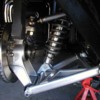I had the same question you did about the control arm bushings, but never did get an answer I could understand. The best explanation I came up with for myself was that, while the rubber part of the bushing does not pivot in the eye of the control arm (because the steel sleeve rotates around the mounting bolt), it will compress and perhaps twist. So my theory is that this causes the squeeking that the grease zerk is intended to address. Mike Drew sort of confirmed this when he wrote elsewhere as follows:
"...realize that the noise you're hearing is NOT coming from the interface
between the outside of the bushing and the inside of the suspension arm. The
noise you're hearing is coming from the ENDS of the bushings where they are
rotating against the yoke. The mounting bolts use Nylock nuts, and they are
just supposed to be snug, no more. Some people go crazy and torque the hell out
of the nuts, which pinches the yokes and basically binds up the suspension;
the thing then creaks something wicked."
The sleeve-to-bolt contact, being metal on metal, may not be as inclined to squeek? Anyway, not being one to question the wisdom established by people who know infinitely more than I do, I installed zerks exactly as shown in the photo you posted and, for what it's worth, I have had no squeeking so far.
While we're on the subject of grease zerks, here's my stab at explaining what Pat Mical told me about the lower control arm shafts. His theory is that, in order to get the grease to circulate, you have to grind a spiral groove into either the shaft or the hole in the upright or both (I can't remember which). In short, if you want to install a grease zerk in your rear uprights, I'd give Pat a call and have him explain it to you directly. Either that, or do what I did and order the greasable shaft kit from Pantera East and save yourself a whole lot of trouble.


